BSBMGT403 Implement Continuous Improvement: Learner Workbook
VerifiedAdded on 2023/06/09
|40
|6531
|304
Homework Assignment
AI Summary
This document provides a comprehensive overview of the BSBMGT403 Implement Continuous Improvement unit, outlining the assessment criteria, elements for competency demonstration, foundation skills, and assessment requirements. It includes details on implementing continuous improvement systems and processes, monitoring and reviewing performance, and providing opportunities for further improvement. The document also features observation checklists, third-party reports, and assessment tool definitions, emphasizing the importance of practical demonstrations and continuous improvement techniques in achieving competency within the unit. The learner workbook activities, case studies, and major activities are essential components for students to complete to demonstrate their understanding and skills in implementing continuous improvement strategies.
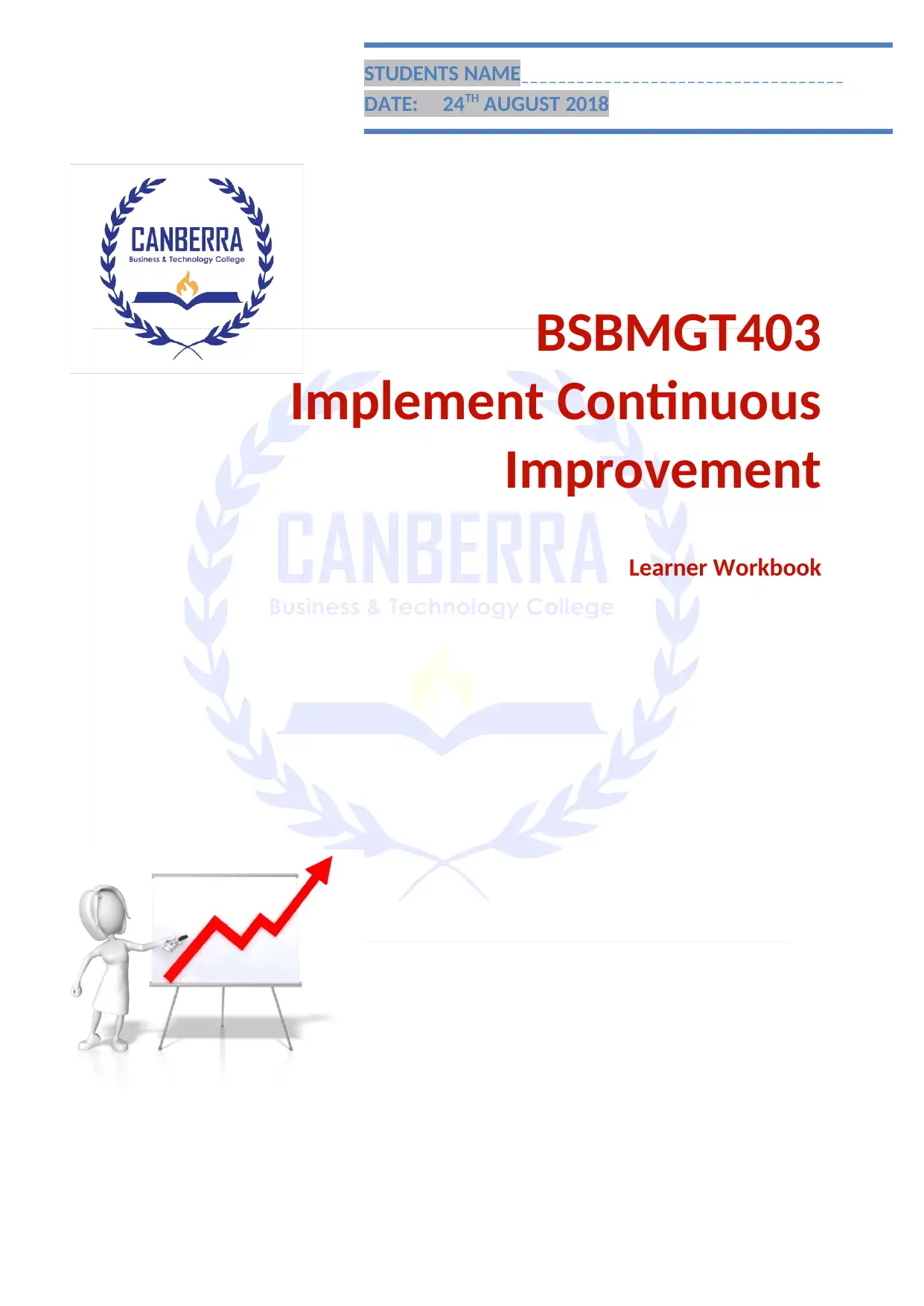
BSBMGT403
Implement Continuous
Improvement
Learner Workbook
STUDENTS NAME___________________________________
DATE: 24TH AUGUST 2018
Implement Continuous
Improvement
Learner Workbook
STUDENTS NAME___________________________________
DATE: 24TH AUGUST 2018
Paraphrase This Document
Need a fresh take? Get an instant paraphrase of this document with our AI Paraphraser
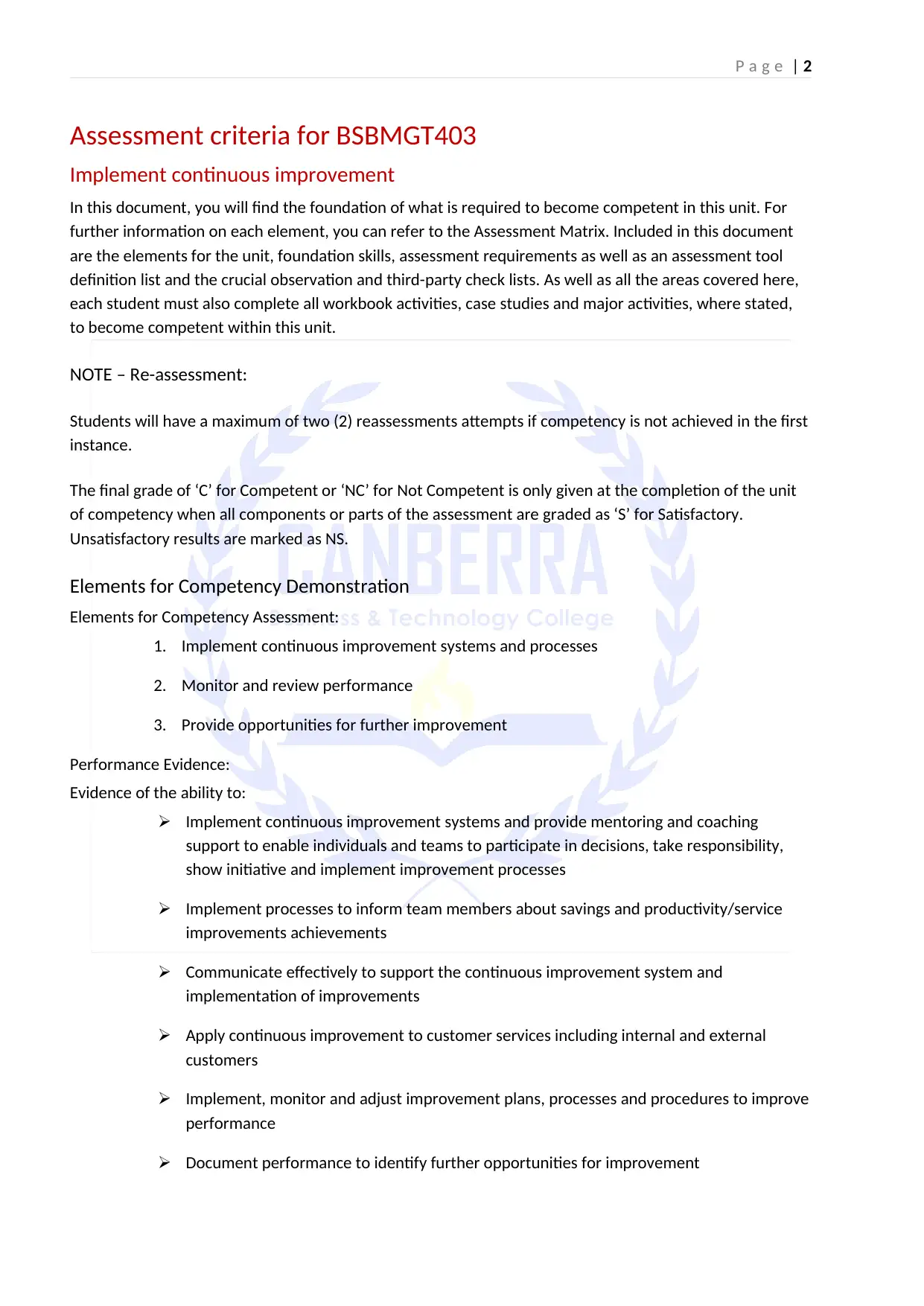
P a g e | 2
Assessment criteria for BSBMGT403
Implement continuous improvement
In this document, you will find the foundation of what is required to become competent in this unit. For
further information on each element, you can refer to the Assessment Matrix. Included in this document
are the elements for the unit, foundation skills, assessment requirements as well as an assessment tool
definition list and the crucial observation and third-party check lists. As well as all the areas covered here,
each student must also complete all workbook activities, case studies and major activities, where stated,
to become competent within this unit.
NOTE – Re-assessment:
Students will have a maximum of two (2) reassessments attempts if competency is not achieved in the first
instance.
The final grade of ‘C’ for Competent or ‘NC’ for Not Competent is only given at the completion of the unit
of competency when all components or parts of the assessment are graded as ‘S’ for Satisfactory.
Unsatisfactory results are marked as NS.
Elements for Competency Demonstration
Elements for Competency Assessment:
1. Implement continuous improvement systems and processes
2. Monitor and review performance
3. Provide opportunities for further improvement
Performance Evidence:
Evidence of the ability to:
Implement continuous improvement systems and provide mentoring and coaching
support to enable individuals and teams to participate in decisions, take responsibility,
show initiative and implement improvement processes
Implement processes to inform team members about savings and productivity/service
improvements achievements
Communicate effectively to support the continuous improvement system and
implementation of improvements
Apply continuous improvement to customer services including internal and external
customers
Implement, monitor and adjust improvement plans, processes and procedures to improve
performance
Document performance to identify further opportunities for improvement
Assessment criteria for BSBMGT403
Implement continuous improvement
In this document, you will find the foundation of what is required to become competent in this unit. For
further information on each element, you can refer to the Assessment Matrix. Included in this document
are the elements for the unit, foundation skills, assessment requirements as well as an assessment tool
definition list and the crucial observation and third-party check lists. As well as all the areas covered here,
each student must also complete all workbook activities, case studies and major activities, where stated,
to become competent within this unit.
NOTE – Re-assessment:
Students will have a maximum of two (2) reassessments attempts if competency is not achieved in the first
instance.
The final grade of ‘C’ for Competent or ‘NC’ for Not Competent is only given at the completion of the unit
of competency when all components or parts of the assessment are graded as ‘S’ for Satisfactory.
Unsatisfactory results are marked as NS.
Elements for Competency Demonstration
Elements for Competency Assessment:
1. Implement continuous improvement systems and processes
2. Monitor and review performance
3. Provide opportunities for further improvement
Performance Evidence:
Evidence of the ability to:
Implement continuous improvement systems and provide mentoring and coaching
support to enable individuals and teams to participate in decisions, take responsibility,
show initiative and implement improvement processes
Implement processes to inform team members about savings and productivity/service
improvements achievements
Communicate effectively to support the continuous improvement system and
implementation of improvements
Apply continuous improvement to customer services including internal and external
customers
Implement, monitor and adjust improvement plans, processes and procedures to improve
performance
Document performance to identify further opportunities for improvement
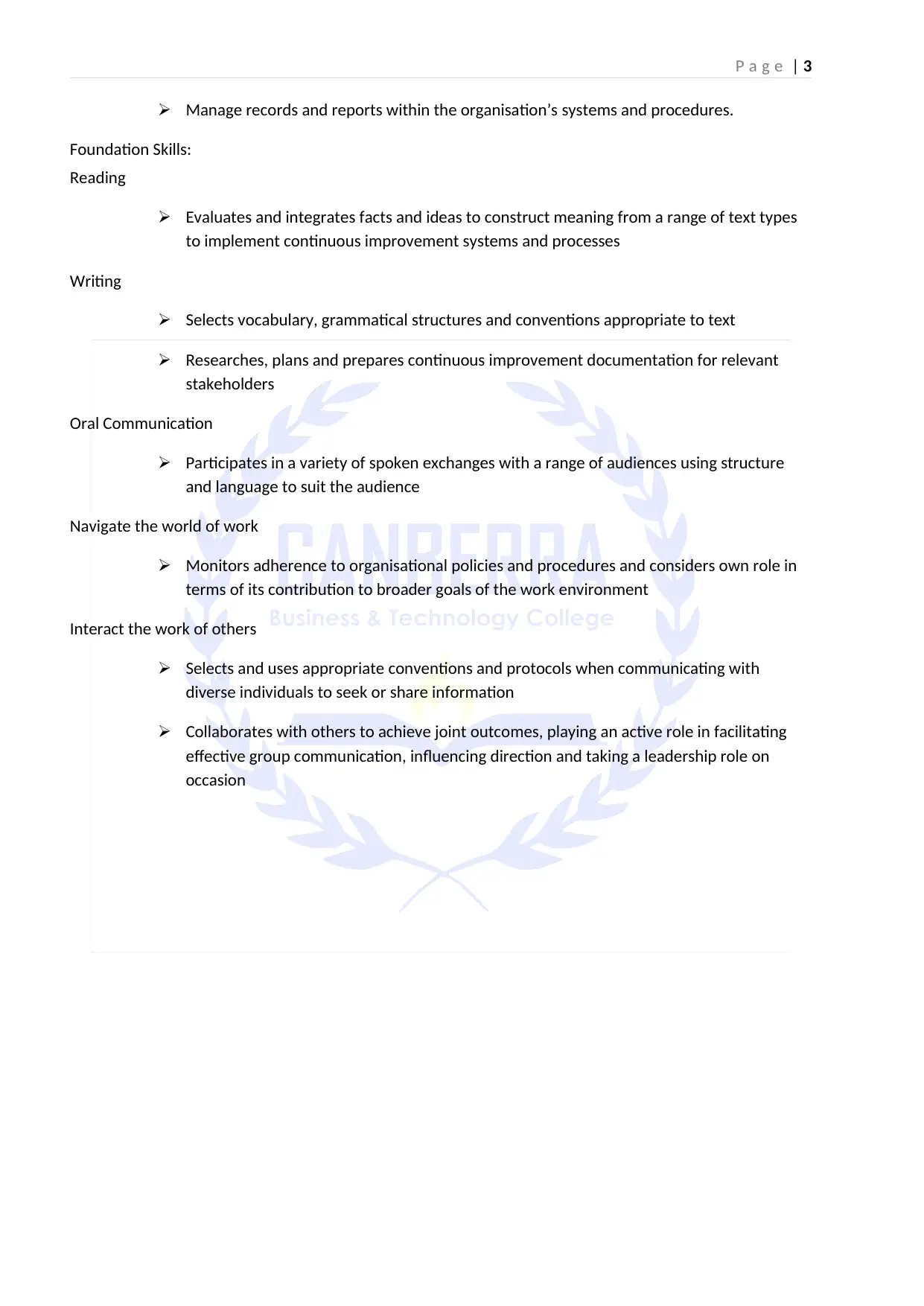
P a g e | 3
Manage records and reports within the organisation’s systems and procedures.
Foundation Skills:
Reading
Evaluates and integrates facts and ideas to construct meaning from a range of text types
to implement continuous improvement systems and processes
Writing
Selects vocabulary, grammatical structures and conventions appropriate to text
Researches, plans and prepares continuous improvement documentation for relevant
stakeholders
Oral Communication
Participates in a variety of spoken exchanges with a range of audiences using structure
and language to suit the audience
Navigate the world of work
Monitors adherence to organisational policies and procedures and considers own role in
terms of its contribution to broader goals of the work environment
Interact the work of others
Selects and uses appropriate conventions and protocols when communicating with
diverse individuals to seek or share information
Collaborates with others to achieve joint outcomes, playing an active role in facilitating
effective group communication, influencing direction and taking a leadership role on
occasion
Manage records and reports within the organisation’s systems and procedures.
Foundation Skills:
Reading
Evaluates and integrates facts and ideas to construct meaning from a range of text types
to implement continuous improvement systems and processes
Writing
Selects vocabulary, grammatical structures and conventions appropriate to text
Researches, plans and prepares continuous improvement documentation for relevant
stakeholders
Oral Communication
Participates in a variety of spoken exchanges with a range of audiences using structure
and language to suit the audience
Navigate the world of work
Monitors adherence to organisational policies and procedures and considers own role in
terms of its contribution to broader goals of the work environment
Interact the work of others
Selects and uses appropriate conventions and protocols when communicating with
diverse individuals to seek or share information
Collaborates with others to achieve joint outcomes, playing an active role in facilitating
effective group communication, influencing direction and taking a leadership role on
occasion
⊘ This is a preview!⊘
Do you want full access?
Subscribe today to unlock all pages.

Trusted by 1+ million students worldwide
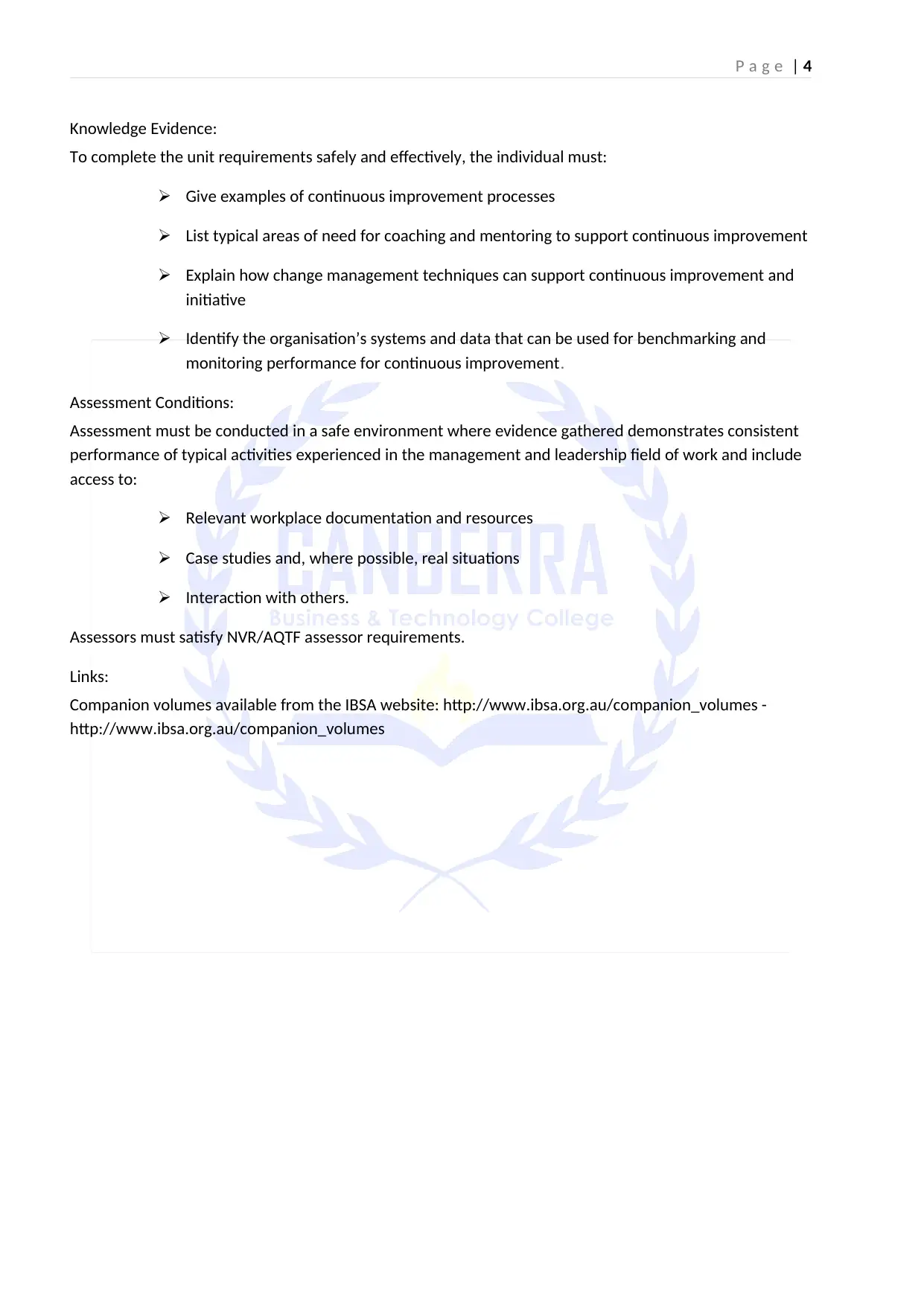
P a g e | 4
Knowledge Evidence:
To complete the unit requirements safely and effectively, the individual must:
Give examples of continuous improvement processes
List typical areas of need for coaching and mentoring to support continuous improvement
Explain how change management techniques can support continuous improvement and
initiative
Identify the organisation’s systems and data that can be used for benchmarking and
monitoring performance for continuous improvement.
Assessment Conditions:
Assessment must be conducted in a safe environment where evidence gathered demonstrates consistent
performance of typical activities experienced in the management and leadership field of work and include
access to:
Relevant workplace documentation and resources
Case studies and, where possible, real situations
Interaction with others.
Assessors must satisfy NVR/AQTF assessor requirements.
Links:
Companion volumes available from the IBSA website: http://www.ibsa.org.au/companion_volumes -
http://www.ibsa.org.au/companion_volumes
Knowledge Evidence:
To complete the unit requirements safely and effectively, the individual must:
Give examples of continuous improvement processes
List typical areas of need for coaching and mentoring to support continuous improvement
Explain how change management techniques can support continuous improvement and
initiative
Identify the organisation’s systems and data that can be used for benchmarking and
monitoring performance for continuous improvement.
Assessment Conditions:
Assessment must be conducted in a safe environment where evidence gathered demonstrates consistent
performance of typical activities experienced in the management and leadership field of work and include
access to:
Relevant workplace documentation and resources
Case studies and, where possible, real situations
Interaction with others.
Assessors must satisfy NVR/AQTF assessor requirements.
Links:
Companion volumes available from the IBSA website: http://www.ibsa.org.au/companion_volumes -
http://www.ibsa.org.au/companion_volumes
Paraphrase This Document
Need a fresh take? Get an instant paraphrase of this document with our AI Paraphraser
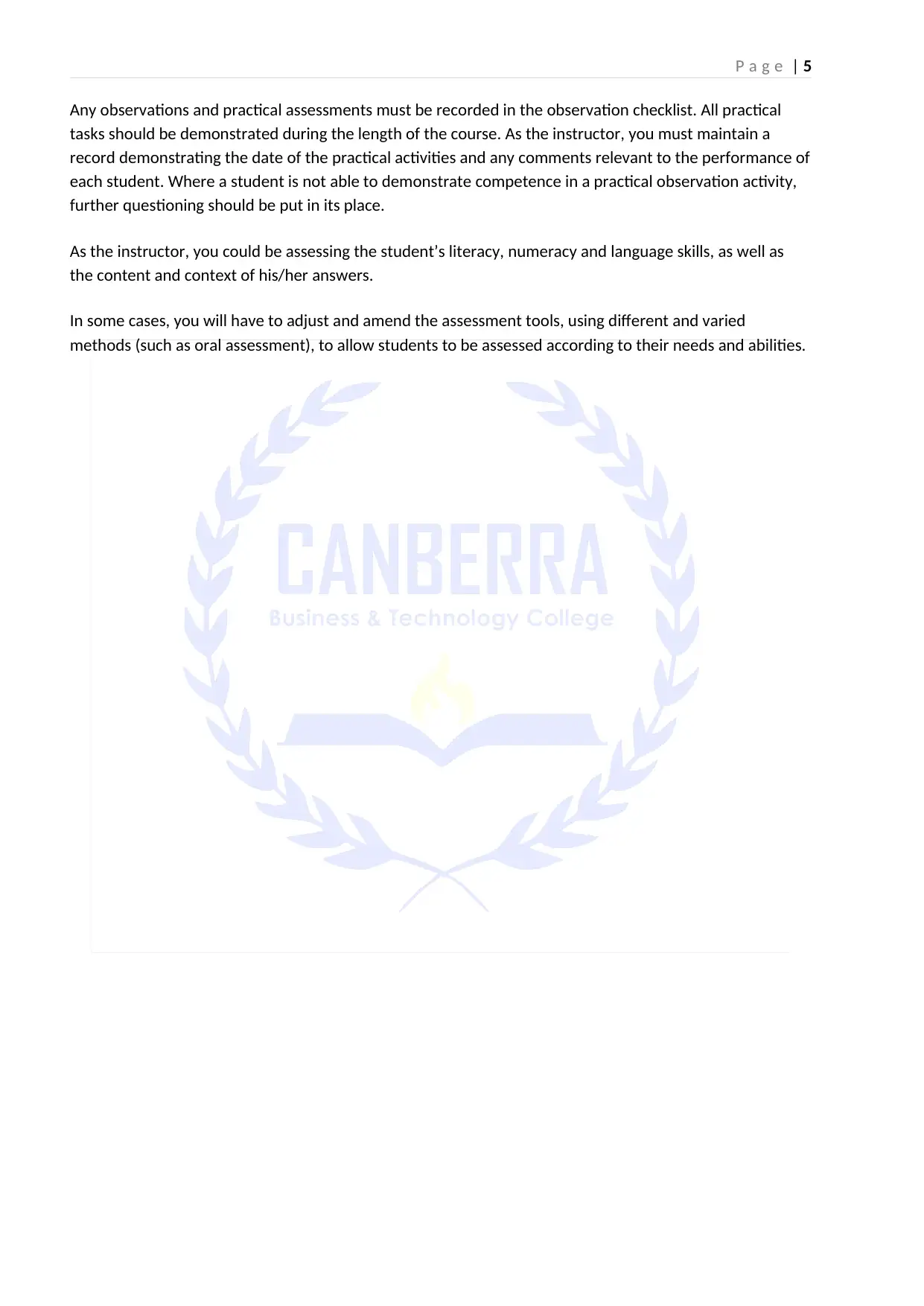
P a g e | 5
Any observations and practical assessments must be recorded in the observation checklist. All practical
tasks should be demonstrated during the length of the course. As the instructor, you must maintain a
record demonstrating the date of the practical activities and any comments relevant to the performance of
each student. Where a student is not able to demonstrate competence in a practical observation activity,
further questioning should be put in its place.
As the instructor, you could be assessing the student’s literacy, numeracy and language skills, as well as
the content and context of his/her answers.
In some cases, you will have to adjust and amend the assessment tools, using different and varied
methods (such as oral assessment), to allow students to be assessed according to their needs and abilities.
Any observations and practical assessments must be recorded in the observation checklist. All practical
tasks should be demonstrated during the length of the course. As the instructor, you must maintain a
record demonstrating the date of the practical activities and any comments relevant to the performance of
each student. Where a student is not able to demonstrate competence in a practical observation activity,
further questioning should be put in its place.
As the instructor, you could be assessing the student’s literacy, numeracy and language skills, as well as
the content and context of his/her answers.
In some cases, you will have to adjust and amend the assessment tools, using different and varied
methods (such as oral assessment), to allow students to be assessed according to their needs and abilities.
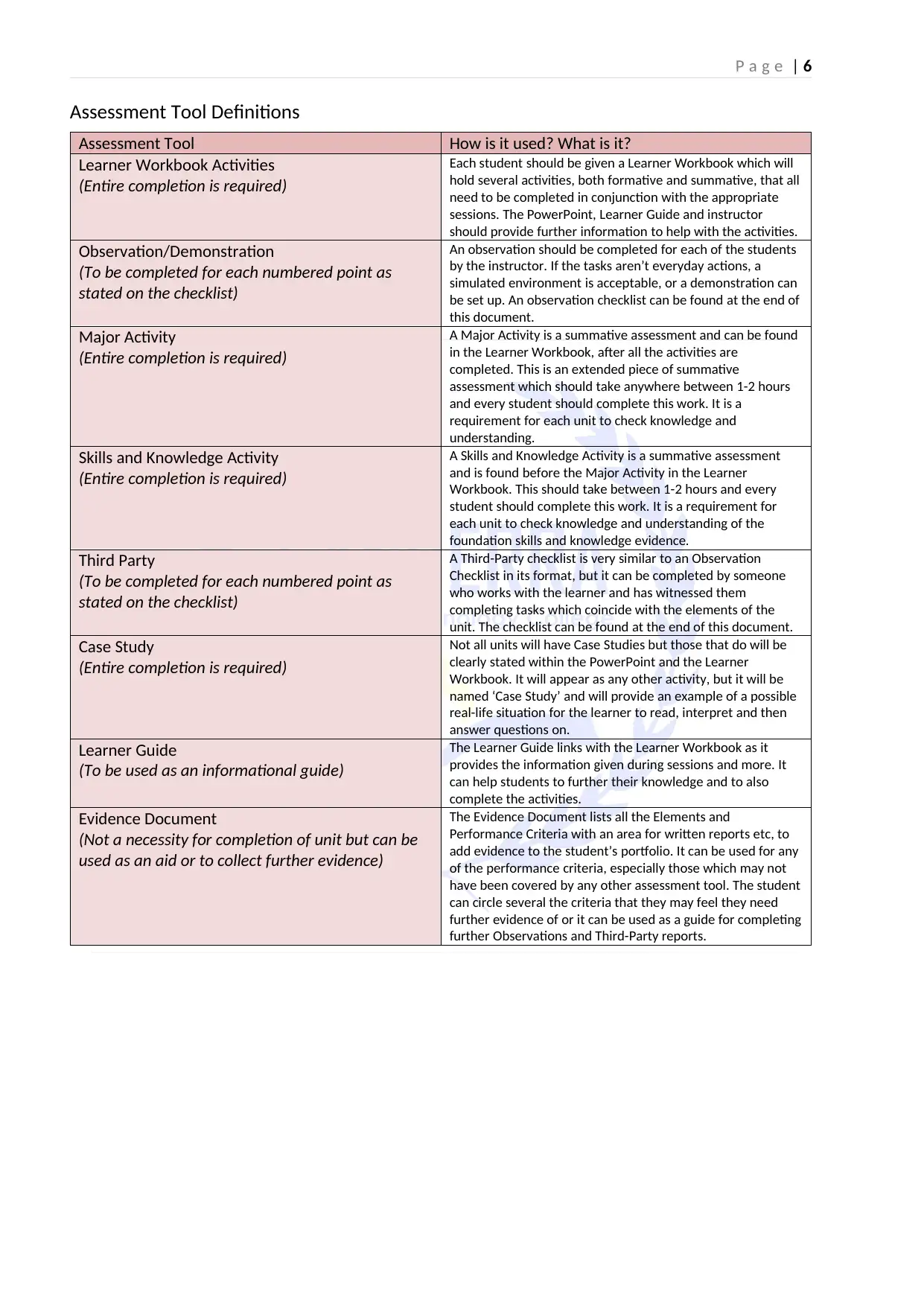
P a g e | 6
Assessment Tool Definitions
Assessment Tool How is it used? What is it?
Learner Workbook Activities
(Entire completion is required)
Each student should be given a Learner Workbook which will
hold several activities, both formative and summative, that all
need to be completed in conjunction with the appropriate
sessions. The PowerPoint, Learner Guide and instructor
should provide further information to help with the activities.
Observation/Demonstration
(To be completed for each numbered point as
stated on the checklist)
An observation should be completed for each of the students
by the instructor. If the tasks aren’t everyday actions, a
simulated environment is acceptable, or a demonstration can
be set up. An observation checklist can be found at the end of
this document.
Major Activity
(Entire completion is required)
A Major Activity is a summative assessment and can be found
in the Learner Workbook, after all the activities are
completed. This is an extended piece of summative
assessment which should take anywhere between 1-2 hours
and every student should complete this work. It is a
requirement for each unit to check knowledge and
understanding.
Skills and Knowledge Activity
(Entire completion is required)
A Skills and Knowledge Activity is a summative assessment
and is found before the Major Activity in the Learner
Workbook. This should take between 1-2 hours and every
student should complete this work. It is a requirement for
each unit to check knowledge and understanding of the
foundation skills and knowledge evidence.
Third Party
(To be completed for each numbered point as
stated on the checklist)
A Third-Party checklist is very similar to an Observation
Checklist in its format, but it can be completed by someone
who works with the learner and has witnessed them
completing tasks which coincide with the elements of the
unit. The checklist can be found at the end of this document.
Case Study
(Entire completion is required)
Not all units will have Case Studies but those that do will be
clearly stated within the PowerPoint and the Learner
Workbook. It will appear as any other activity, but it will be
named ‘Case Study’ and will provide an example of a possible
real-life situation for the learner to read, interpret and then
answer questions on.
Learner Guide
(To be used as an informational guide)
The Learner Guide links with the Learner Workbook as it
provides the information given during sessions and more. It
can help students to further their knowledge and to also
complete the activities.
Evidence Document
(Not a necessity for completion of unit but can be
used as an aid or to collect further evidence)
The Evidence Document lists all the Elements and
Performance Criteria with an area for written reports etc, to
add evidence to the student’s portfolio. It can be used for any
of the performance criteria, especially those which may not
have been covered by any other assessment tool. The student
can circle several the criteria that they may feel they need
further evidence of or it can be used as a guide for completing
further Observations and Third-Party reports.
Assessment Tool Definitions
Assessment Tool How is it used? What is it?
Learner Workbook Activities
(Entire completion is required)
Each student should be given a Learner Workbook which will
hold several activities, both formative and summative, that all
need to be completed in conjunction with the appropriate
sessions. The PowerPoint, Learner Guide and instructor
should provide further information to help with the activities.
Observation/Demonstration
(To be completed for each numbered point as
stated on the checklist)
An observation should be completed for each of the students
by the instructor. If the tasks aren’t everyday actions, a
simulated environment is acceptable, or a demonstration can
be set up. An observation checklist can be found at the end of
this document.
Major Activity
(Entire completion is required)
A Major Activity is a summative assessment and can be found
in the Learner Workbook, after all the activities are
completed. This is an extended piece of summative
assessment which should take anywhere between 1-2 hours
and every student should complete this work. It is a
requirement for each unit to check knowledge and
understanding.
Skills and Knowledge Activity
(Entire completion is required)
A Skills and Knowledge Activity is a summative assessment
and is found before the Major Activity in the Learner
Workbook. This should take between 1-2 hours and every
student should complete this work. It is a requirement for
each unit to check knowledge and understanding of the
foundation skills and knowledge evidence.
Third Party
(To be completed for each numbered point as
stated on the checklist)
A Third-Party checklist is very similar to an Observation
Checklist in its format, but it can be completed by someone
who works with the learner and has witnessed them
completing tasks which coincide with the elements of the
unit. The checklist can be found at the end of this document.
Case Study
(Entire completion is required)
Not all units will have Case Studies but those that do will be
clearly stated within the PowerPoint and the Learner
Workbook. It will appear as any other activity, but it will be
named ‘Case Study’ and will provide an example of a possible
real-life situation for the learner to read, interpret and then
answer questions on.
Learner Guide
(To be used as an informational guide)
The Learner Guide links with the Learner Workbook as it
provides the information given during sessions and more. It
can help students to further their knowledge and to also
complete the activities.
Evidence Document
(Not a necessity for completion of unit but can be
used as an aid or to collect further evidence)
The Evidence Document lists all the Elements and
Performance Criteria with an area for written reports etc, to
add evidence to the student’s portfolio. It can be used for any
of the performance criteria, especially those which may not
have been covered by any other assessment tool. The student
can circle several the criteria that they may feel they need
further evidence of or it can be used as a guide for completing
further Observations and Third-Party reports.
⊘ This is a preview!⊘
Do you want full access?
Subscribe today to unlock all pages.

Trusted by 1+ million students worldwide
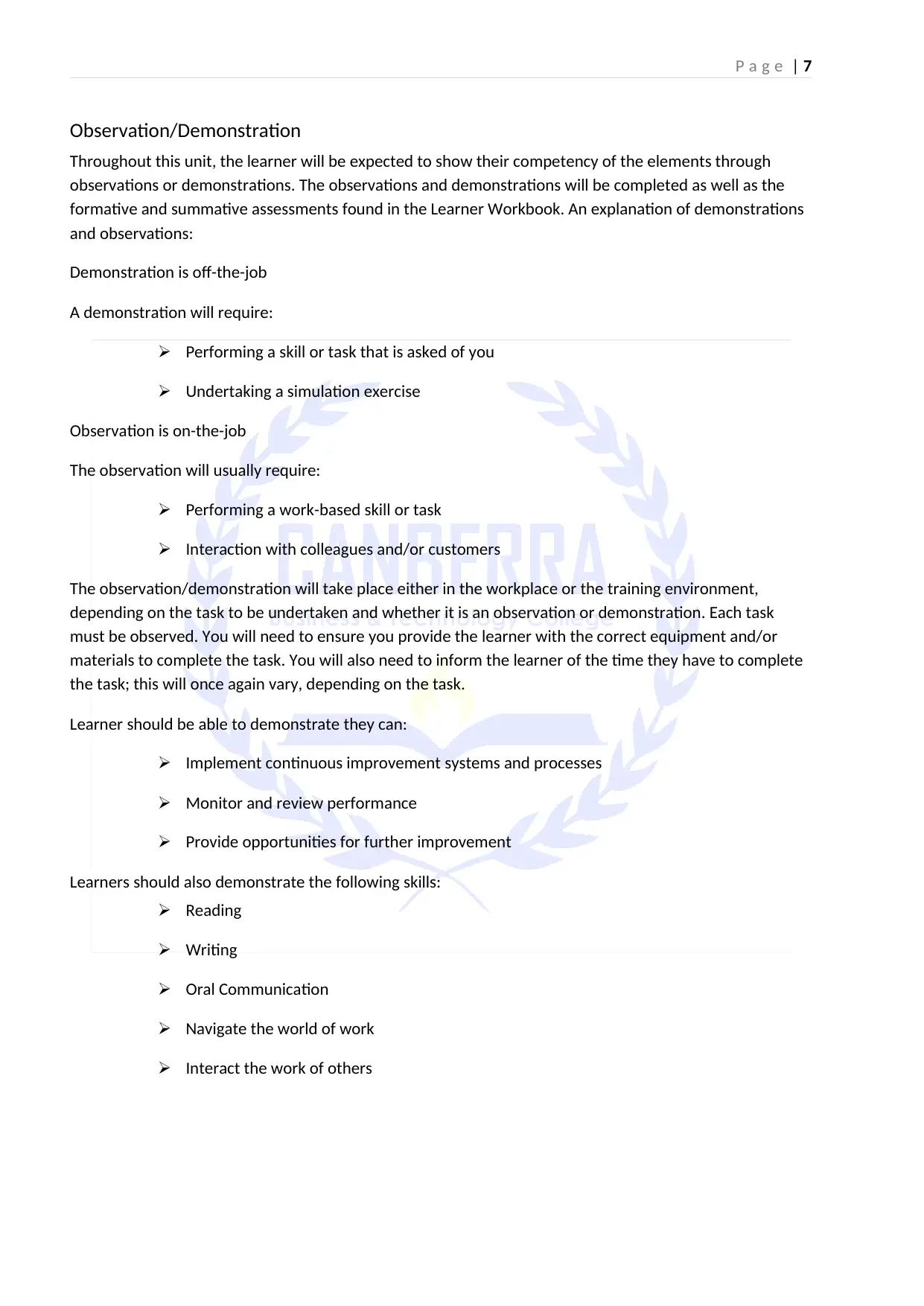
P a g e | 7
Observation/Demonstration
Throughout this unit, the learner will be expected to show their competency of the elements through
observations or demonstrations. The observations and demonstrations will be completed as well as the
formative and summative assessments found in the Learner Workbook. An explanation of demonstrations
and observations:
Demonstration is off-the-job
A demonstration will require:
Performing a skill or task that is asked of you
Undertaking a simulation exercise
Observation is on-the-job
The observation will usually require:
Performing a work-based skill or task
Interaction with colleagues and/or customers
The observation/demonstration will take place either in the workplace or the training environment,
depending on the task to be undertaken and whether it is an observation or demonstration. Each task
must be observed. You will need to ensure you provide the learner with the correct equipment and/or
materials to complete the task. You will also need to inform the learner of the time they have to complete
the task; this will once again vary, depending on the task.
Learner should be able to demonstrate they can:
Implement continuous improvement systems and processes
Monitor and review performance
Provide opportunities for further improvement
Learners should also demonstrate the following skills:
Reading
Writing
Oral Communication
Navigate the world of work
Interact the work of others
Observation/Demonstration
Throughout this unit, the learner will be expected to show their competency of the elements through
observations or demonstrations. The observations and demonstrations will be completed as well as the
formative and summative assessments found in the Learner Workbook. An explanation of demonstrations
and observations:
Demonstration is off-the-job
A demonstration will require:
Performing a skill or task that is asked of you
Undertaking a simulation exercise
Observation is on-the-job
The observation will usually require:
Performing a work-based skill or task
Interaction with colleagues and/or customers
The observation/demonstration will take place either in the workplace or the training environment,
depending on the task to be undertaken and whether it is an observation or demonstration. Each task
must be observed. You will need to ensure you provide the learner with the correct equipment and/or
materials to complete the task. You will also need to inform the learner of the time they have to complete
the task; this will once again vary, depending on the task.
Learner should be able to demonstrate they can:
Implement continuous improvement systems and processes
Monitor and review performance
Provide opportunities for further improvement
Learners should also demonstrate the following skills:
Reading
Writing
Oral Communication
Navigate the world of work
Interact the work of others
Paraphrase This Document
Need a fresh take? Get an instant paraphrase of this document with our AI Paraphraser
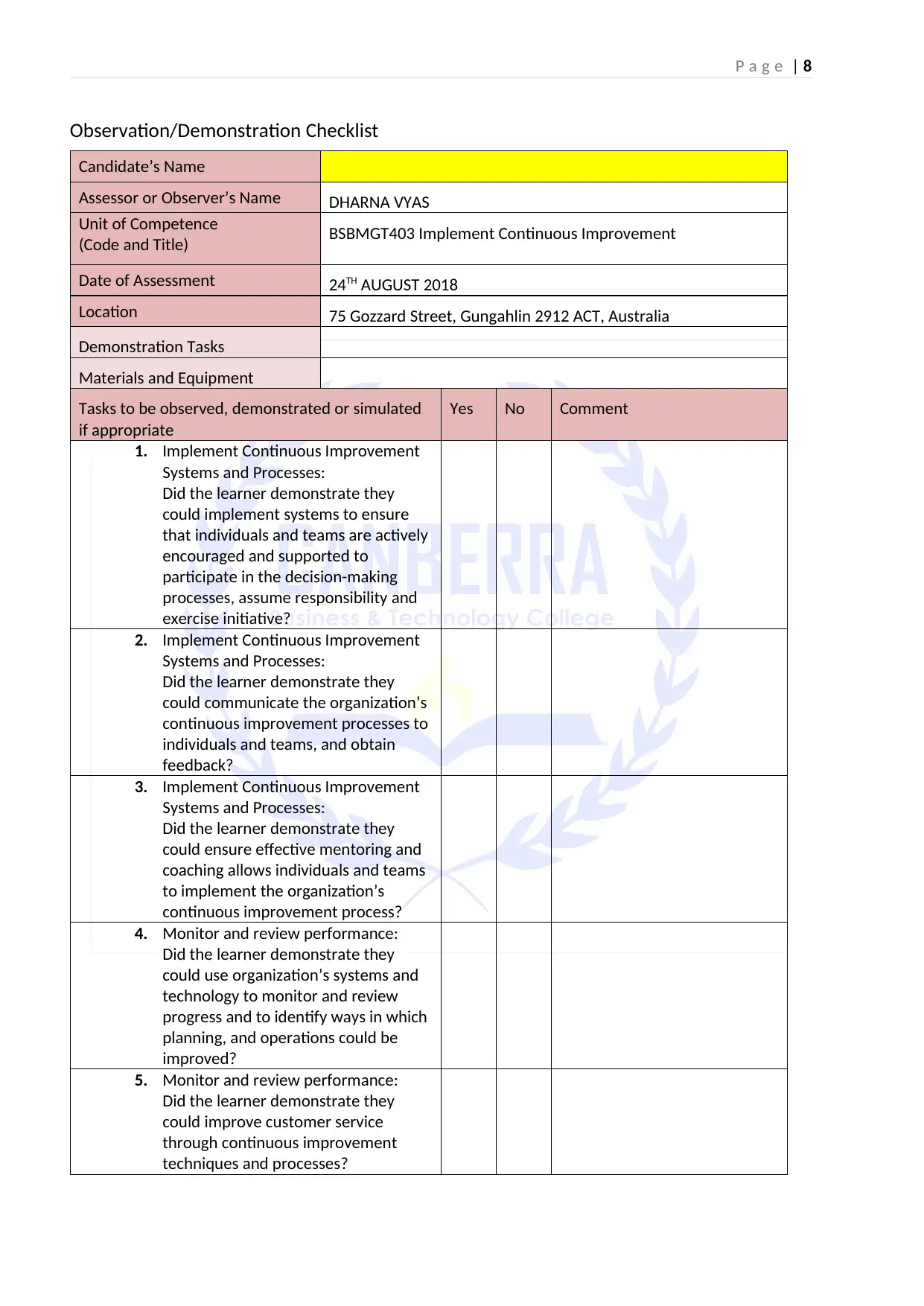
P a g e | 8
Observation/Demonstration Checklist
Candidate’s Name
Assessor or Observer’s Name DHARNA VYAS
Unit of Competence
(Code and Title) BSBMGT403 Implement Continuous Improvement
Date of Assessment 24TH AUGUST 2018
Location 75 Gozzard Street, Gungahlin 2912 ACT, Australia
Demonstration Tasks
Materials and Equipment
Tasks to be observed, demonstrated or simulated
if appropriate
Yes No Comment
1. Implement Continuous Improvement
Systems and Processes:
Did the learner demonstrate they
could implement systems to ensure
that individuals and teams are actively
encouraged and supported to
participate in the decision-making
processes, assume responsibility and
exercise initiative?
2. Implement Continuous Improvement
Systems and Processes:
Did the learner demonstrate they
could communicate the organization’s
continuous improvement processes to
individuals and teams, and obtain
feedback?
3. Implement Continuous Improvement
Systems and Processes:
Did the learner demonstrate they
could ensure effective mentoring and
coaching allows individuals and teams
to implement the organization’s
continuous improvement process?
4. Monitor and review performance:
Did the learner demonstrate they
could use organization’s systems and
technology to monitor and review
progress and to identify ways in which
planning, and operations could be
improved?
5. Monitor and review performance:
Did the learner demonstrate they
could improve customer service
through continuous improvement
techniques and processes?
Observation/Demonstration Checklist
Candidate’s Name
Assessor or Observer’s Name DHARNA VYAS
Unit of Competence
(Code and Title) BSBMGT403 Implement Continuous Improvement
Date of Assessment 24TH AUGUST 2018
Location 75 Gozzard Street, Gungahlin 2912 ACT, Australia
Demonstration Tasks
Materials and Equipment
Tasks to be observed, demonstrated or simulated
if appropriate
Yes No Comment
1. Implement Continuous Improvement
Systems and Processes:
Did the learner demonstrate they
could implement systems to ensure
that individuals and teams are actively
encouraged and supported to
participate in the decision-making
processes, assume responsibility and
exercise initiative?
2. Implement Continuous Improvement
Systems and Processes:
Did the learner demonstrate they
could communicate the organization’s
continuous improvement processes to
individuals and teams, and obtain
feedback?
3. Implement Continuous Improvement
Systems and Processes:
Did the learner demonstrate they
could ensure effective mentoring and
coaching allows individuals and teams
to implement the organization’s
continuous improvement process?
4. Monitor and review performance:
Did the learner demonstrate they
could use organization’s systems and
technology to monitor and review
progress and to identify ways in which
planning, and operations could be
improved?
5. Monitor and review performance:
Did the learner demonstrate they
could improve customer service
through continuous improvement
techniques and processes?
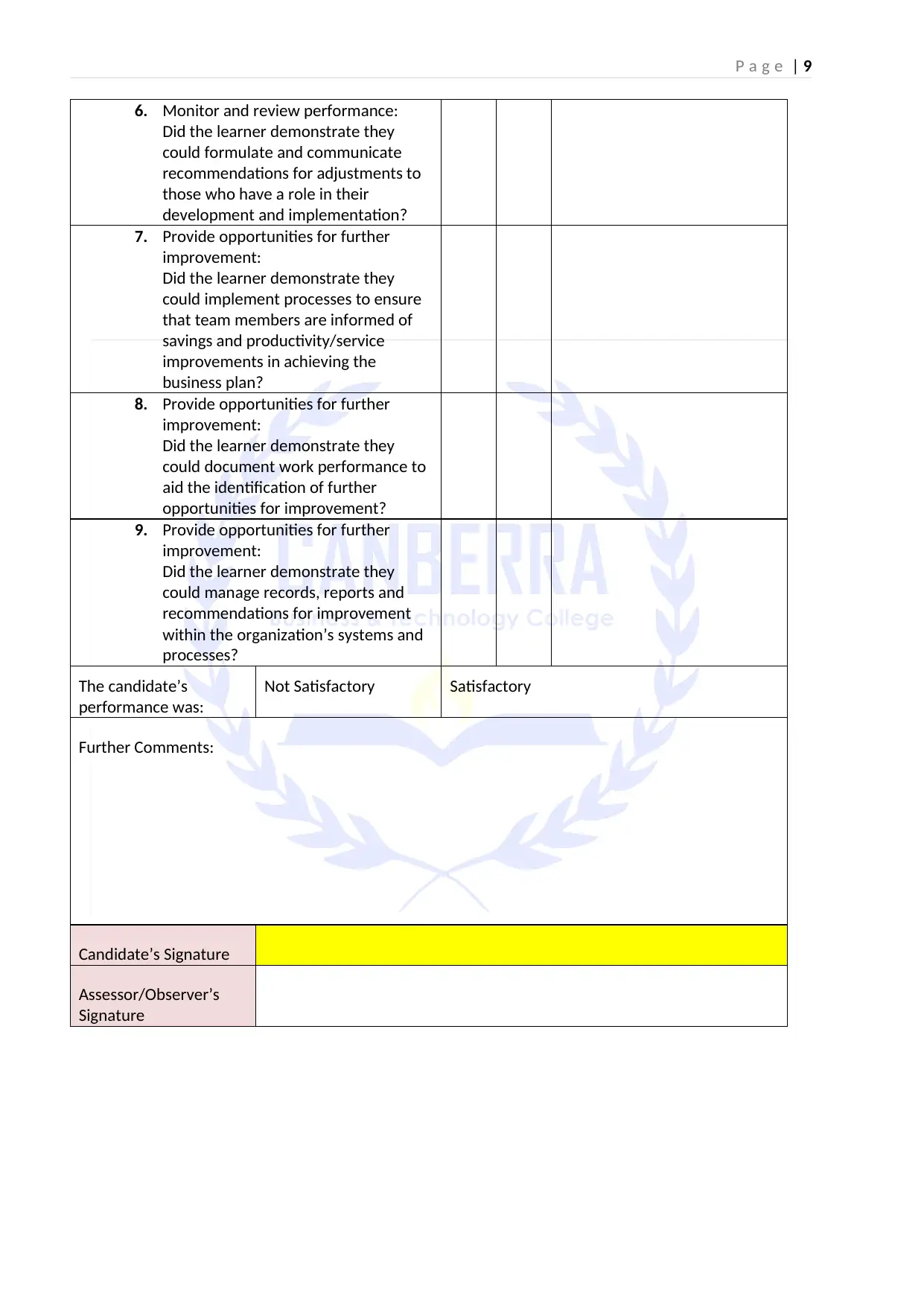
P a g e | 9
6. Monitor and review performance:
Did the learner demonstrate they
could formulate and communicate
recommendations for adjustments to
those who have a role in their
development and implementation?
7. Provide opportunities for further
improvement:
Did the learner demonstrate they
could implement processes to ensure
that team members are informed of
savings and productivity/service
improvements in achieving the
business plan?
8. Provide opportunities for further
improvement:
Did the learner demonstrate they
could document work performance to
aid the identification of further
opportunities for improvement?
9. Provide opportunities for further
improvement:
Did the learner demonstrate they
could manage records, reports and
recommendations for improvement
within the organization’s systems and
processes?
The candidate’s
performance was:
Not Satisfactory Satisfactory
Further Comments:
Candidate’s Signature
Assessor/Observer’s
Signature
6. Monitor and review performance:
Did the learner demonstrate they
could formulate and communicate
recommendations for adjustments to
those who have a role in their
development and implementation?
7. Provide opportunities for further
improvement:
Did the learner demonstrate they
could implement processes to ensure
that team members are informed of
savings and productivity/service
improvements in achieving the
business plan?
8. Provide opportunities for further
improvement:
Did the learner demonstrate they
could document work performance to
aid the identification of further
opportunities for improvement?
9. Provide opportunities for further
improvement:
Did the learner demonstrate they
could manage records, reports and
recommendations for improvement
within the organization’s systems and
processes?
The candidate’s
performance was:
Not Satisfactory Satisfactory
Further Comments:
Candidate’s Signature
Assessor/Observer’s
Signature
⊘ This is a preview!⊘
Do you want full access?
Subscribe today to unlock all pages.

Trusted by 1+ million students worldwide
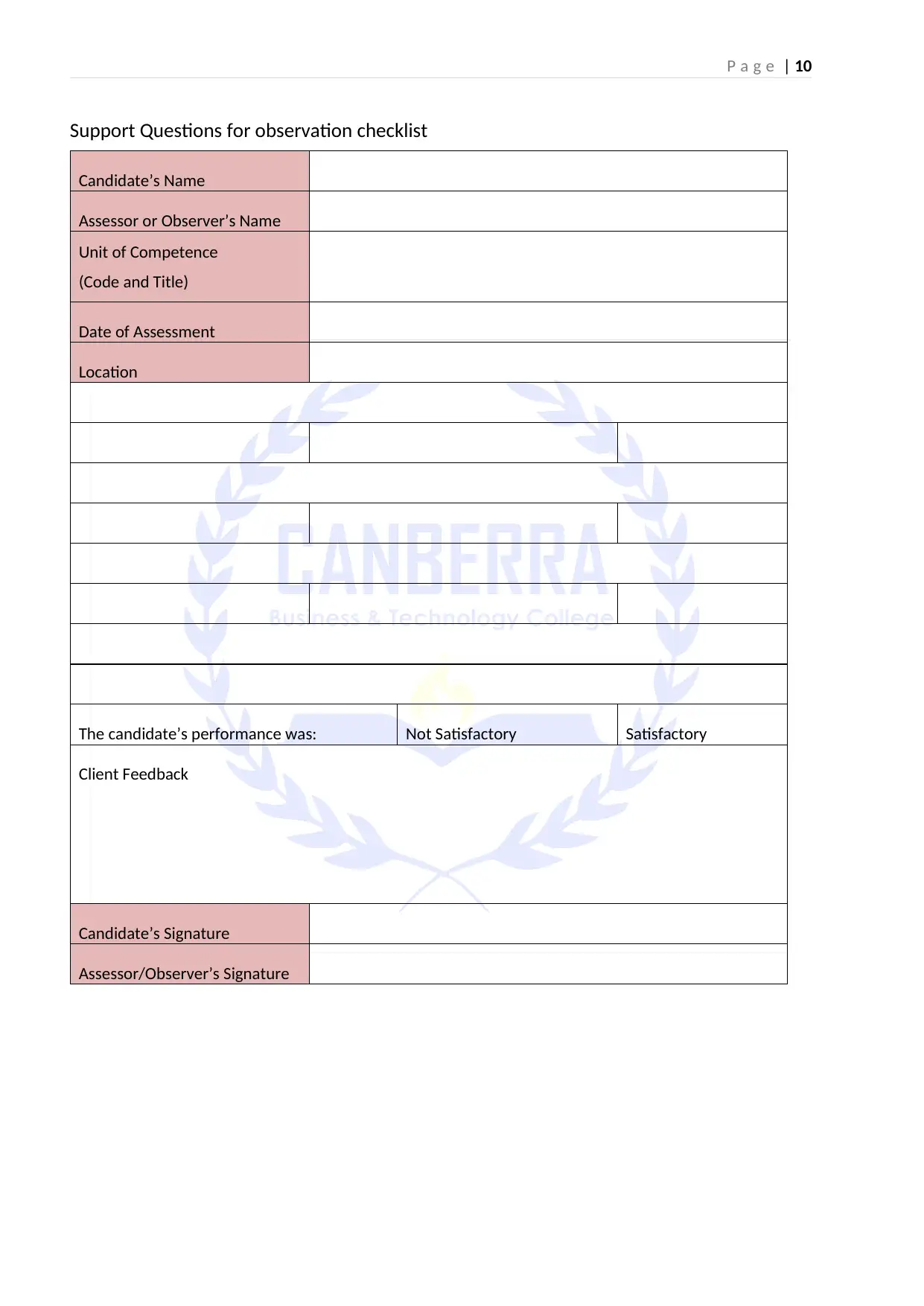
P a g e | 10
Support Questions for observation checklist
Candidate’s Name
Assessor or Observer’s Name
Unit of Competence
(Code and Title)
Date of Assessment
Location
The candidate’s performance was: Not Satisfactory Satisfactory
Client Feedback
Candidate’s Signature
Assessor/Observer’s Signature
Support Questions for observation checklist
Candidate’s Name
Assessor or Observer’s Name
Unit of Competence
(Code and Title)
Date of Assessment
Location
The candidate’s performance was: Not Satisfactory Satisfactory
Client Feedback
Candidate’s Signature
Assessor/Observer’s Signature
Paraphrase This Document
Need a fresh take? Get an instant paraphrase of this document with our AI Paraphraser
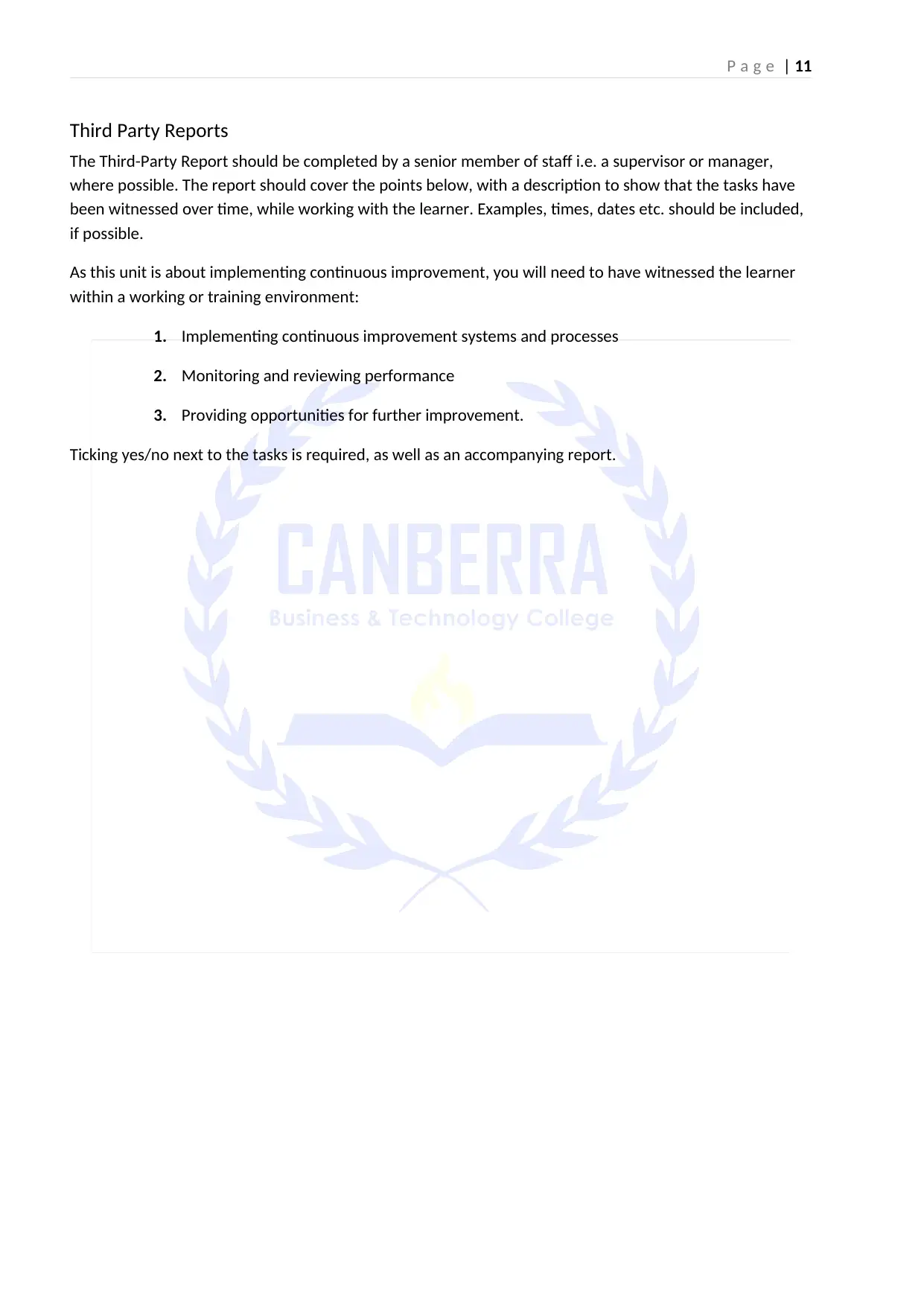
P a g e | 11
Third Party Reports
The Third-Party Report should be completed by a senior member of staff i.e. a supervisor or manager,
where possible. The report should cover the points below, with a description to show that the tasks have
been witnessed over time, while working with the learner. Examples, times, dates etc. should be included,
if possible.
As this unit is about implementing continuous improvement, you will need to have witnessed the learner
within a working or training environment:
1. Implementing continuous improvement systems and processes
2. Monitoring and reviewing performance
3. Providing opportunities for further improvement.
Ticking yes/no next to the tasks is required, as well as an accompanying report.
Third Party Reports
The Third-Party Report should be completed by a senior member of staff i.e. a supervisor or manager,
where possible. The report should cover the points below, with a description to show that the tasks have
been witnessed over time, while working with the learner. Examples, times, dates etc. should be included,
if possible.
As this unit is about implementing continuous improvement, you will need to have witnessed the learner
within a working or training environment:
1. Implementing continuous improvement systems and processes
2. Monitoring and reviewing performance
3. Providing opportunities for further improvement.
Ticking yes/no next to the tasks is required, as well as an accompanying report.
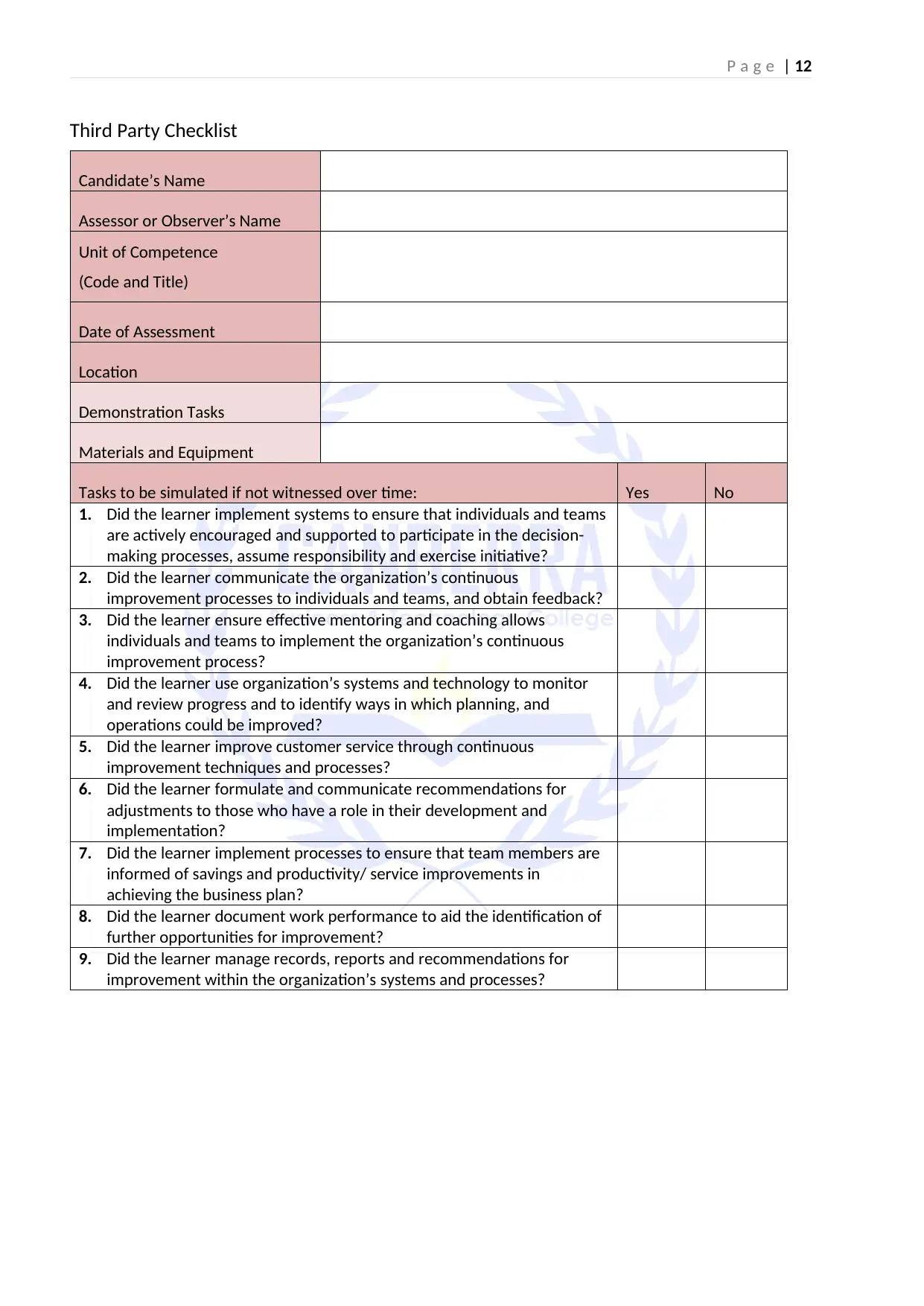
P a g e | 12
Third Party Checklist
Candidate’s Name
Assessor or Observer’s Name
Unit of Competence
(Code and Title)
Date of Assessment
Location
Demonstration Tasks
Materials and Equipment
Tasks to be simulated if not witnessed over time: Yes No
1. Did the learner implement systems to ensure that individuals and teams
are actively encouraged and supported to participate in the decision-
making processes, assume responsibility and exercise initiative?
2. Did the learner communicate the organization’s continuous
improvement processes to individuals and teams, and obtain feedback?
3. Did the learner ensure effective mentoring and coaching allows
individuals and teams to implement the organization’s continuous
improvement process?
4. Did the learner use organization’s systems and technology to monitor
and review progress and to identify ways in which planning, and
operations could be improved?
5. Did the learner improve customer service through continuous
improvement techniques and processes?
6. Did the learner formulate and communicate recommendations for
adjustments to those who have a role in their development and
implementation?
7. Did the learner implement processes to ensure that team members are
informed of savings and productivity/ service improvements in
achieving the business plan?
8. Did the learner document work performance to aid the identification of
further opportunities for improvement?
9. Did the learner manage records, reports and recommendations for
improvement within the organization’s systems and processes?
Third Party Checklist
Candidate’s Name
Assessor or Observer’s Name
Unit of Competence
(Code and Title)
Date of Assessment
Location
Demonstration Tasks
Materials and Equipment
Tasks to be simulated if not witnessed over time: Yes No
1. Did the learner implement systems to ensure that individuals and teams
are actively encouraged and supported to participate in the decision-
making processes, assume responsibility and exercise initiative?
2. Did the learner communicate the organization’s continuous
improvement processes to individuals and teams, and obtain feedback?
3. Did the learner ensure effective mentoring and coaching allows
individuals and teams to implement the organization’s continuous
improvement process?
4. Did the learner use organization’s systems and technology to monitor
and review progress and to identify ways in which planning, and
operations could be improved?
5. Did the learner improve customer service through continuous
improvement techniques and processes?
6. Did the learner formulate and communicate recommendations for
adjustments to those who have a role in their development and
implementation?
7. Did the learner implement processes to ensure that team members are
informed of savings and productivity/ service improvements in
achieving the business plan?
8. Did the learner document work performance to aid the identification of
further opportunities for improvement?
9. Did the learner manage records, reports and recommendations for
improvement within the organization’s systems and processes?
⊘ This is a preview!⊘
Do you want full access?
Subscribe today to unlock all pages.

Trusted by 1+ million students worldwide
1 out of 40
Related Documents
Your All-in-One AI-Powered Toolkit for Academic Success.
+13062052269
info@desklib.com
Available 24*7 on WhatsApp / Email
![[object Object]](/_next/static/media/star-bottom.7253800d.svg)
Unlock your academic potential
Copyright © 2020–2025 A2Z Services. All Rights Reserved. Developed and managed by ZUCOL.





